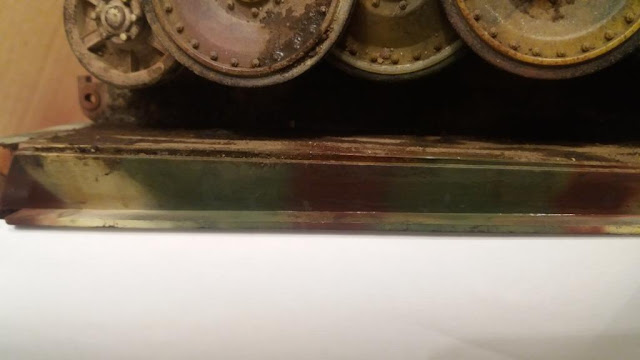For the mud effects, you can use 2 types of products:
- Acrylics paint with earth pigments.
- Enamel weathering products like AK Interactive with earth pigments.
Chipping fluid
PVA Glue or water based varnish.
You can replace the earth pigments by plaster of Paris.
I'm making my own pigments using different kind of earth that I'm collecting here and there.
I will explain later on a specific tutorial how I'm making them.
For the wet effect, again you can go for wet effect product or you can also use gloss varnish.
For the acrylics, I'm using Tamiya. I'm making a mix of:
XF-2 Matt White, XF-60 Dark Yellow, XF-52 Flat Earth, XF-64 Red Brown and XF-1 Flat Black.
For the enamels, I recommend AK Interactive enamels as they are easy to use, you know what the final colour will be:
AK-017 Earth Effect, AK-080 Summer Kursk Earth, AK-010 Fresh Mud.
I start by applying varnish on the hull and the wheels:
Before it's dry I'm putting the pigments:
Next step, on the side of the hull, I'm applying chipping fluid, to avoid any unwanted drop on the upper hull, I'm using some paper to mask it:
To create the mud, I’m mixing home made earth pigments with some paint in a plastic shot glass. If the mixture is too thin, add some more pigments. It must have the same consistency as real mud.
For the mud, always remember to start by the dry mud (the clearest tone) this dry mud must cover more space than the others.
I’m using an old brush, airbrush and toothpick to create the splashes in a very easy way .
Always try first in a piece of paper or the bottom side of the model until you have the desire effect as your bush will be full of mud. You will avoid unwanted (too) big splashes.
The next layer is made with dark earth tone:
I let it dry for few minutes before I’m making the streaking mud using a brush wetted with water (to activate the chipping fluid or hairspray).
Here you can see the result once the streaking mud is done of the side of this Panther.
For the wet effect, you can use gloss varnish or wet effect fluid. Use it with parsimony always keeping in mind a real tank as reference.
You can now repeat the process on the other side, front and rear:
You can also place some muddy foot prints on your tank due to the crew climbing on it with their boots full of mud.























